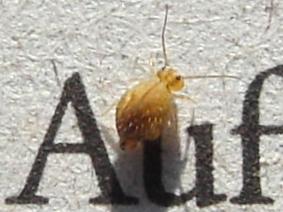|
Dicyrtomidae
Dicyrtomidae is a family of Collembola in the order Symphypleona, and it is the only family of the superfamily Dicyrtomoidea. It includes more than 200 species in eight genera. Genera According to ''Checklist of the Collembola of the World'':Bellinger, Christiansen & Janssens, 1996-2019 : ''Checklist of the Collembola of the World.'Checklist of the Collembola of the World * Dicyrtominae Börner, 1906 ** ''Calvatomina'' Yosii, 1966 ** ''Dicyrtoma'' Bourlet, 1842 ** ''Dicyrtomina'' Börner, 1903 ** ''Gibberathrix'' Uchida, 1952 ** ''Jordanathrix'' Bretfeld & Arbea, 1999 * Ptenothricinae Richards, 1968 ** ''Bothriovulsus'' Richards, 1968 ** ''Papirioides'' Folsom, 1924 ** ''Ptenothrix'' Börner, 1906 References * Börner, 1906 : ''Das System der Collembolen nebst Beschreibung neuer Collembolen des Hamburger Naturhistorischen Museums.'' Mitteilungen aus dem Naturhistorischen Museum in Hamburg, , texte intégral. * Gao, Yan; Bu, Yun & Luan, Yun-Xia (2008): Phylogenetic Relation ... [...More Info...] [...Related Items...] OR: [Wikipedia] [Google] [Baidu] |
Dicyrtoma
''Dicyrtoma'' is a genus of globular springtails in the family Dicyrtomidae. There are at least 30 described species in ''Dicyrtoma''. Species References springtail genera {{springtail-stub ... [...More Info...] [...Related Items...] OR: [Wikipedia] [Google] [Baidu] |
Ptenothrix
''Ptenothrix'' is a genus of globular springtails in the family Dicyrtomidae Dicyrtomidae is a family of Collembola in the order Symphypleona, and it is the only family of the superfamily Dicyrtomoidea. It includes more than 200 species in eight genera. Genera According to ''Checklist of the Collembola of the World'': .... There are about 11 described species in ''Ptenothrix''. Species These 11 species belong to the genus ''Ptenothrix'': * '' Ptenothrix atra'' (Linnaeus, C, 1758) Börner, 1906 * '' Ptenothrix beta'' (Christiansen, K & Bellinger, P, 1981) Christiansen, K & Bellinger, P, 1998 * '' Ptenothrix castanea'' Snider, RJ, 1985 * '' Ptenothrix curvilineata'' Wray, 1949 * '' Ptenothrix flavescens'' (Axelson, 1905) * '' Ptenothrix macomba'' Wray, 1967 * '' Ptenothrix maculosa'' (Schott, 1891) * '' Ptenothrix marmorata'' (Packard, 1873) Mills, HB, 1934 * '' Ptenothrix palmata'' (Folsom, JW, 1902) Stach, J, 1957 * '' Ptenothrix renateae'' Snider, RJ, 1985 * '' Pteno ... [...More Info...] [...Related Items...] OR: [Wikipedia] [Google] [Baidu] |
Symphypleona
The order Symphypleona is one of the three main groups of springtails (Collembola), tiny hexapods related to insects. When the springtails were still believed to be an order of insects, the Symphypleona were ranked as a suborder. They can be best distinguished from the other springtail groups by their body shape. The Symphypleona are very round animals, almost spherical, and usually have long antennae. The Poduromorpha, by contrast, always have short legs and a plump body, but more oval in shape than the Symphypleona. The Entomobryomorpha are the slimmest springtails, some with long and some with short legs and antennae, but always with a very slender body. Systematics The Symphypleona order was previously suggested to also contain family Neelidae, as a very apomorphic relative in the Sminthuridae superfamily. Phylogenetic studies however suggest Neelidae to be the only family of Neelipleona order.Gao, Yan; Bu, Yun & Luan, Yun-Xia (2008): Phylogenetic Relationships of Basa ... [...More Info...] [...Related Items...] OR: [Wikipedia] [Google] [Baidu] |
Dicyrtomina Minuta
''Dicyrtomina minuta'' is a species of globular springtails in the family Dicyrtomidae Dicyrtomidae is a family of Collembola in the order Symphypleona, and it is the only family of the superfamily Dicyrtomoidea. It includes more than 200 species in eight genera. Genera According to ''Checklist of the Collembola of the World'': .... References External links * Collembola Articles created by Qbugbot Animals described in 1783 {{Springtail-stub ... [...More Info...] [...Related Items...] OR: [Wikipedia] [Google] [Baidu] |
Dicyrtominae
Dicyrtominae is a subfamily of globular springtails in the family Dicyrtomidae. There are at least 3 genera and 30 described species in Dicyrtominae. Genera * '' Calvatomina'' * ''Dicyrtoma ''Dicyrtoma'' is a genus of globular springtails in the family Dicyrtomidae. There are at least 30 described species in ''Dicyrtoma''. Species References springtail genera {{springtail-stub ...'' Bourlet, 1841 * '' Dicyrtomina'' Börner, 1903 References Collembola Arthropod subfamilies {{springtail-stub ... [...More Info...] [...Related Items...] OR: [Wikipedia] [Google] [Baidu] |
Dicyrtomina
''Dicyrtomina'' is a genus of globular springtails in the family Dicyrtomidae. There are about five described species in ''Dicyrtomina''. Species These five species belong to the genus ''Dicyrtomina'': * '' Dicyrtomina flavosignata'' (Tullberg, 1871) * ''Dicyrtomina minuta'' (Fabricius, 1783) * '' Dicyrtomina ornata'' (Nicolet, 1842) * '' Dicyrtomina saundersi'' (Lubbock, 1862) * '' Dicyrtomina violacea'' (Krausbauer, 1898) g Data sources: i = ITIS, c = Catalogue of Life, g = GBIF, b = Bugguide.net References Further reading * External links * Collembola Articles created by Qbugbot Springtail genera {{Springtail-stub ... [...More Info...] [...Related Items...] OR: [Wikipedia] [Google] [Baidu] |
Animalia
Animals are multicellular, eukaryotic organisms in the biological kingdom Animalia. With few exceptions, animals consume organic material, breathe oxygen, are able to move, can reproduce sexually, and go through an ontogenetic stage in which their body consists of a hollow sphere of cells, the blastula, during embryonic development. Over 1.5 million living animal species have been described—of which around 1 million are insects—but it has been estimated there are over 7 million animal species in total. Animals range in length from to . They have complex interactions with each other and their environments, forming intricate food webs. The scientific study of animals is known as zoology. Most living animal species are in Bilateria, a clade whose members have a bilaterally symmetric body plan. The Bilateria include the protostomes, containing animals such as nematodes, arthropods, flatworms, annelids and molluscs, and the deuterostomes, containing the echinode ... [...More Info...] [...Related Items...] OR: [Wikipedia] [Google] [Baidu] |


.jpg)
